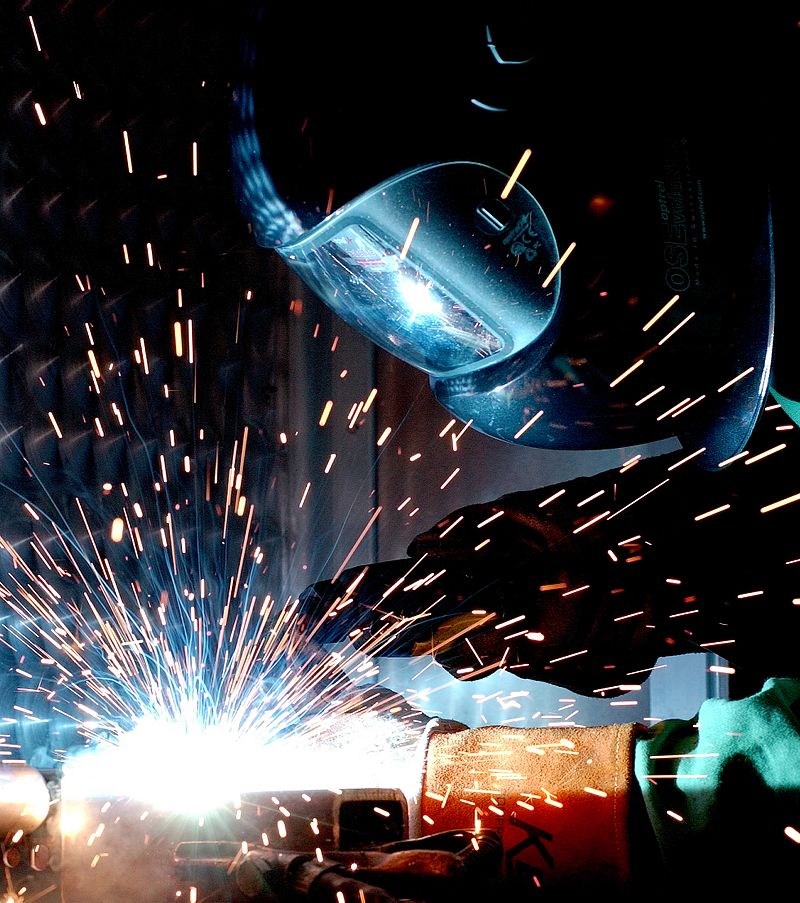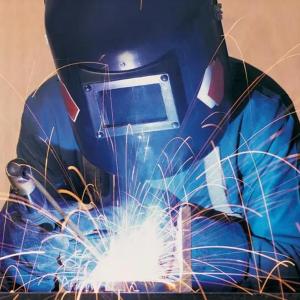Some Welding knowledge-Welding Fabrication
Some Welding knowledge-China Welding Fabrication
Welding, or welding, welding, or welding, is a process and technique for joining metals or other thermoplastics by heat or pressure. Welding achieves the purpose of joining through the following three ways:
Heating the workpieces to be joined to make them melt locally to form a molten pool. After the molten pool cools and solidifies, it is joined. If necessary, a filler can be added to assist.
Solder with lower melting point is heated separately without melting the workpiece itself, and the workpiece is connected by the capillary action of the solder (such as soldering, brazing).
At a temperature equal to or lower than the melting point of the workpiece, supplemented by high pressure, superimposed extrusion or vibration, etc., the two workpieces can be infiltrated and joined (such as forging welding, solid-state welding).
According to the specific welding process, welding can be subdivided into gas welding, resistance welding, arc welding, induction welding and laser welding and other special welding.
There are many energy sources for welding, including gas flame, arc, laser, electron beam, friction and ultrasonic. In addition to being used in factories, welding can be performed in a variety of environments, such as in the field, underwater, and in space. Welding can be dangerous to the operator wherever it is, so proper precautions must be taken when welding. The possible injuries caused by welding to the human body include burns, electric shock, visual impairment, inhalation of toxic gases, and excessive ultraviolet radiation.
Before the end of the 19th century, the only welding process was metal forging, which blacksmiths have used for hundreds of years. The earliest modern welding techniques appeared at the end of the 19th century, first arc welding and oxy-fuel welding, and later resistance welding. In the early 20th century, there was a great demand for military equipment in World War I and World War II, and the corresponding cheap and reliable metal joining process was valued, which in turn promoted the development of welding technology. After the war, several modern welding techniques emerged successively, including the most popular at present, manual electric arc welding, as well as techniques such as gas metal arc welding, submerged arc welding (submerged arc welding), flux-cored arc welding, and electroslag welding. Automatic or semi-automatic welding technology. In the second half of the 20th century, welding technology developed rapidly, and laser welding and electron beam welding were developed. Today, welding robots are widely used in industrial production. Researchers are still delving into the nature of welding, continuing to develop new welding methods and further improve the quality of welding.
The history of metal joining goes back thousands of years, with early welding techniques seen in Bronze Age and Iron Age Europe and the Middle East. The two river civilizations thousands of years ago have begun to use soldering technology [1]. In the first 340 years, welding technology was used in the manufacture of the 5.4-ton Indian Delhi iron pillar [2].
Medieval blacksmiths made connections by continuously forging red-hot metal, a process known as forge welding. The technique of forging and welding was described in the book "Pyrology" by Wiener Billingerseo in 1540. Forge welding was well mastered by Renaissance artisans, and the technique continued to improve over the following centuries [3]. By the 19th century, the development of welding technology has advanced by leaps and bounds, and its appearance has been greatly improved. In 1800, Sir Humphrey Davy discovered the electric arc; later, the metal electrode invented by the Russian scientist Nikulei Slavyenov and the American scientist C.L. Goffin promoted the formation of the arc welding process. Arc welding and the later developed carbon arc welding using carbon electrodes are widely used in industrial production. Around 1900, A.P. Stroganov developed metal-clad carbon electrodes in England that could provide a more stable arc; in 1919, C.J. Holslag for welding, but this technique was not widely used until a decade later [4].
Resistance welding was developed during the last decade of the 19th century, and the first patent on resistance welding was filed in 1885 by Elihu Thomson, who continued to improve the technique over the next 15 years. Aluminothermic welding and combustible gas welding were invented in 1893. Edmund Davy discovered acetylene in 1836, and around 1900, gas welding began to be widely used due to the advent of a new type of gas torch [5]. Combustible gas welding has been one of the most popular welding techniques in the beginning due to its cheapness and good mobility. However, with the continuous improvement of the metal coating technology on the electrode surface by engineers in the 20th century (that is, the development of flux), the new electrode can provide a more stable arc and can effectively isolate the base metal and impurities. It can gradually replace combustible welding and become the most widely used industrial welding technology [6].
The First World War caused a surge in demand for welding, and countries were actively researching new welding technologies. Mainly arc welding was used in the UK, and they built the first all-welded hull ship, the Frago. During the war, arc welding was also used for the first time in aircraft manufacturing. For example, the airframes of many German aircraft were manufactured in this way [7]. It is also worth noting that the world's first all-welded road bridge was built in 1929 over the Słudwia Maurzyce River near Wówki, Poland by Stefan Bryła of the Warsaw Institute of Technology. Designed in 1927 [8].
The 1920s saw a major breakthrough in welding technology. Automatic welding appeared in 1920, and the continuity of the arc was ensured by an automatic wire feeder. Shielding gases received extensive attention during this period. Because the metal at high temperature reacts chemically with oxygen and nitrogen in the atmosphere during the welding process, the resulting voids and compounds will affect the strength of the joint. The solution is to use hydrogen, argon, and helium to isolate the molten pool from the atmosphere [9]. Over the next 10 years, further advances in welding technology made it possible to weld reactive metals such as aluminum and magnesium. The introduction of automatic welding, alternating current, and active agents greatly facilitated the development of arc welding from the 1930s to World War II [10].
In the mid-20th century, scientists and engineers invented a variety of new welding techniques. Stud welding (planted stud welding), invented in 1930, soon became widely used in shipbuilding and construction. Submerged arc welding, invented in the same year, is still very popular today. After decades of development, gas tungsten arc welding was finally perfected in 1941. Then in 1948, gas-shielded arc welding made rapid welding of non-ferrous metals possible, but this technique required the consumption of large and expensive shielding gases. Manual arc welding with consumable electrodes as electrodes was developed in the 1950s and quickly became the most popular metal arc welding technology. In 1957, flux-cored arc welding first appeared, and its self-shielded wire electrode can be used for automatic welding, which greatly improves the welding speed. In the same year, plasma arc welding was invented. Electroslag welding was invented in 1958, and gas welding was invented in 1961 [11].
Recent advances in welding technology include: Electron beam welding in 1958 was able to heat a small area, making it possible to weld deep and elongated workpieces. Then laser welding was invented in 1960, and in the decades that followed, it proved to be the most effective high-speed automatic welding technology. However, electron beam welding and laser welding techniques are limited in their application range due to the high price of the equipment required



